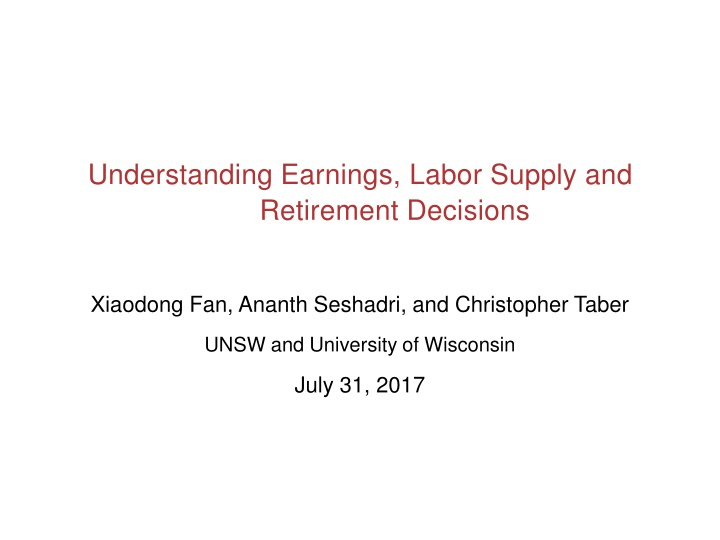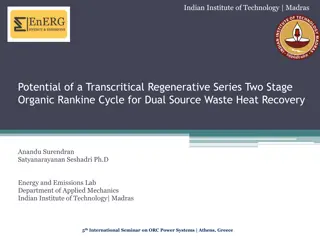
Modeling Retirement Decisions and Labor Supply Dynamics
Explore a model that explains the intricate relationship between wages, labor supply, and retirement decisions without age-dependent preferences or technologies. Endogenizing lifecycle wages and retirement dates can offer key insights for social security policies.
Download Presentation

Please find below an Image/Link to download the presentation.
The content on the website is provided AS IS for your information and personal use only. It may not be sold, licensed, or shared on other websites without obtaining consent from the author. If you encounter any issues during the download, it is possible that the publisher has removed the file from their server.
You are allowed to download the files provided on this website for personal or commercial use, subject to the condition that they are used lawfully. All files are the property of their respective owners.
The content on the website is provided AS IS for your information and personal use only. It may not be sold, licensed, or shared on other websites without obtaining consent from the author.
E N D
Presentation Transcript
Understanding Earnings, Labor Supply and Retirement Decisions Xiaodong Fan, Ananth Seshadri, and Christopher Taber UNSW and University of Wisconsin July 31, 2017
Basic Goal Modeling retirement behavior is fundamental to understanding effects of policy changes on retiree well-being The goal of this work is to estimate a human capital investment model with labor supply to jointly explain Lifecycle profiles of wages Lifecycle profile of labor supply Main Goal: Retirement arises endogenously as a labor supply decision in which individuals optimally bunch leisure late in life
The Challenge Build a model that can reconcile The large increase in wages and small increase in labor supply at the beginning of the lifecycle The small decrease in wages and large decrease in labor supply at the end of the lifecycle Try to explain this without allowing preferences or technologies to depend explicitly on age.
Why do we care? Human Capital literature: endogenizes lifecycle wages taking the retirement date as exogenous. Retirement date is crucial Retirement literature: endogenizes retirement taking the wage pattern as exogenous. Wage pattern is crucial Our goal is to endogenize both within the same model Matters for social security policy questions: if changes in social security system induces people to retire later, human capital investments will change
Data We use SIPP Large panel data set We condition on white males with exactly 12 years of education We have data on essentially worked last week and wage last week Consider the mean profiles by age (estimation focuses on 22-65)
Some Considerations Shape of the wage profile near retirement is crucial However, there is a major selection problem in that we only observe wages for non-retirees A simple solution is to use fixed effects. Here we run a regression of log wages on age dummies and individual specific fixed effects We plot the estimated age dummies along with mean log wages
The Baseline Model Extensive margin of labor supply Individuals maximize utility from consumption and leisure Human capital investment makes earnings endogenous Time used for work, human capital accumulation or leisure We account for social security rules and taxes Since Heckman (1975,1976) very little work combining Human Capital theory with Labor supply
Model Features In the data we see almost flat wages but a large decline in labor supply for middle age/older workers Difficult to explain this without a very large labor supply elasticity Why are people working so little when they are old even though their wages appear high? Two features of our model will help explain this Other than social security, precautionary savings, and selection on wages
1. Depreciation There is a shadow cost to not working Human capital depreciates Even middle age workers need to invest in human capital or their wages will decline In the simplest labor supply model if wages were the same at age 50 and 70 there is no reason why labor supply should be lower at 70 than at 50. Individuals don t "retire during their middle ages because of depreciation, when they return at 60 their wages would be very low
2. Wages and human capital are different Measured wages are (1 It) Ht Measured wages can remain flat when Ht is falling if It is falling as well. Since lifecycle Itdeclines as people age, human capital has to fall faster than wages Can reconcile a relatively small decline in wages with a relatively big decline in labor supply Without resorting to a very large labor supply elasticity
Moments We estimate using Indirect Inference with six sets of moment conditions from SIPP to represent the life-cycle profiles. The labor force participation rate 22-65; The first moments of the logarithm of wages 22-65; The first moments of the logarithm of wages after controlling for individual fixed effects 22-65; The second moments of the logarithm of wages 22-65; The first moments of consumption 27-65; The overall transition rates: E to U and U to E. Total Sample Size: 230,657 observations from 80,519 individuals
Parameter Estimates Baseline Model Parameters Estimates 0.433 0.101 0.076 0.151 0.405 424,070 Standard Errors (0.012) (0.007) (0.019) (0.021) (0.082) (90,735) Leisure: Standard Deviation of Shock Human Capital Depreciation Human Capital Production Function: I factor Human Capital Production Function: H factor Standard Deviation of Human Capital Innovation Bequest Weight Parameter heterogeneityb Leisure: Mean of Intercept Leisure: Standard Deviation of Intercept Human Capital Productivity, Mean Human Capital Productivity, Standard Deviation Correlation between a0 and Initial Human Capital Level at Age 18 Intercept Coefficient on a0 Coefficient on Standard Deviation of Error Term a I H b1 a0 a0 6.525 0.874 1.758 0.583 0.893 (0.050) (0.053) (0.069) (0.026) (0.064) 1.625 0.052 0.531 0.239 (0.099) (0.007) (0.060) (0.036) 0 a0 H0
Health One potentially important element of the model is health- we include it to see it s quantitative significance Health status is a new state variable Affects tastes for leisure, and interact this with age We estimate transition from PSID We fit age pattern of interaction between health and Age (from CPS) It appears to be relatively unimportant
Policy Counterfactuals We conduct several counterfactual policy experiments 1. Increase Tax Rate by 50% 2. Remove the Social Security earnings test, 3. Delay Normal Retirement Age (NRA) two years 4. Remove the Social Security system completely 5. Remove the Social Security system-taxes only 6. Remove the Social Security system-benefit only 7. Decrease the Social Security benefit by 20%
Increase Tax 50% % change No Earnings Test % change NRA = 67 % change Baseline Level Panel A: Baseline Model LFPR Effective Labor Pre-tax Income Average lnw Human Capital Investment 40.356 37.997 637.759 2.613 917.382 2.359 3.096 3.125 4.521 0.468 2.823 2.631 0.959 0.957 0.916 0.322 0.705 0.988 1.012 1.006 1.330 0.268 0.836 1.122 Panel B: Exogenous Model LFPR Effective Labor Pre-tax Income Average lnw 40.412 40.412 655.258 2.625 3.771 3.771 3.945 0.248 0.208 0.208 0.274 0.015 0.835 0.835 0.799 0.024
Baseline Level Reduce SSB 20% NO SS No SS Taxes NO SS Benefit Panel A: Baseline Model LFPR Effective Labor Pre-tax Income Average lnw Human Capital Investment 40.356 37.997 637.759 2.613 917.382 2.359 1.570 1.563 2.165 0.569 1.326 1.684 -4.826 -4.790 -7.143 -0.777 -4.354 -5.395 12.934 6.560 12.926 6.585 15.280 5.826 1.903 8.946 13.059 6.147 0.792 3.681 Panel B: Exogenous Model LFPR Effective Labor Pre-tax Income Average lnw 40.412 40.412 655.258 2.625 1.311 1.311 1.264 0.076 -5.475 -5.475 -5.118 -0.103 8.552 8.552 7.705 -0.009 -0.069 2.245 2.245 2.030
Conclusion Model is able to fit wage and labor supply profiles well Model produces retirement endogenously Depreciation of human capital is really key to understanding retirement decisions And Health shocks play a much less important role Policy responses to changes in SS benefits are meaningfully different from model with exogenous wage processes


